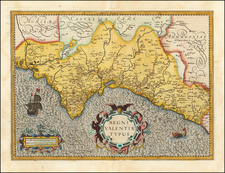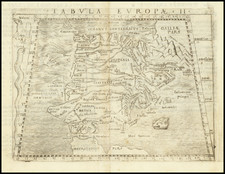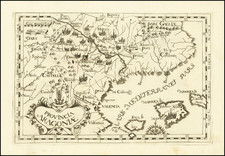Detailed plan of the Bay of Cadíz with fortifications and sailing directions
This informative chart offers a glimpse of the Bay of Cadíz in the eighteenth century, when Cadíz was the most important naval base in Spain. It explains how to safely navigate the shallow waters of the Bay and also highlights the considerable fortifications built to protect the strategic city.
Navigation of muddy waters
The map shows the principal fortifications in red and offers sailing directions so as to avoid the bay's rocks, sand bars, and sediment; these are located in a title box in the upper left corner. The Bay of Cadiz, in the eighteenth century as today, fills with sediment from the various channels and rivers that empty into it, including the Guadalete and the man-made San Pedro Rivers. In addition, tsunamis can deposit huge amounts of materials into the Bay; the last time this happened was after the 1755 Lisbon earthquake. The reach of the sediment is shown on the map with the yellow lines hugging the shore lines. Soundings are also included to indicate where waters are too shallow for safe navigation. A red line with letters shows the best passage through the Bay and corresponds to the detailed directions in the title box.
A strategic city
Although it was not the largest shipyard in Spain (that honor went to Ferrol), it was the capital of the navy department, was located on the Atlantic Coast, and had amassed great wealth. Since the Spanish began their expansion in the Americas, Sevilla, up the Guadalquivir River, had served as the primary port for Americas trade. However, in the eighteenth century, the silting and sand bars in the river made it more expedient that Cadiz be used instead. The Casa de Contratación, which housed the management and information, including maps, of the Spanish Empire moved to Cadiz in 1717.
Even before it became the seat of the Americas trade, Cadiz had been an important port. Christopher Columbus sailed from there on his second and fourth voyages. This prominence also made Cadiz vulnerable to attack, for example by Francis Drake in 1587 and the Dukes of Essex and Nottingham in 1596. The latter assault left the city in charred ruins. The engineer Cristobál de Rojas was tasked with increasing the city's fortifications. He added to the city walls and fortified Caleta, a strategic beach, with two forts, one of which was Castillo de Santa Catalina; both can be seen on the map. These improvements worked, as the city repelled attack in 1625, 1655, 1702, and 1797.
In the 1720s, the city added Castillo de San Sebastián, a battery. Interestingly, none of the defensive walls of the city are named, including the heavily-gunned Baluarte de San Carlos that was built in 1784. Fort Luis, or Castillo de San Luis, is marked across the channel from Cadiz. It was a battery built in the 1600s and then expanded in the eighteenth century. It is likely the map was made in the mid-eighteenth century, as Cadiz began its economic and defensive Renaissance.
http://www.uca.es/recursos/doc/AUI/Recursos/Constitucion_1812/125018741_2082010104040.pdf
Luque, L., Lario, J., Civis, J., Silva, P. G., Zazo, C., Goy, J. L. and Dabrio, C. J. (2002), Sedimentary record of a tsunami during Roman times, Bay of Cadiz, Spain. J. Quaternary Sci., 17: 623–631. doi:10.1002/jqs.711









![[Palma, Tenerife, Gomera, Hierro] Isla Canarias 1a. Hoja](https://storage.googleapis.com/raremaps/img/small/79081.jpg)
![[Spain & Portugal] Tabula Europae II](https://storage.googleapis.com/raremaps/img/small/89871.jpg)
![[ Spain & Portugal ] Hispania Nova Tabula](https://storage.googleapis.com/raremaps/img/small/103676.jpg)


